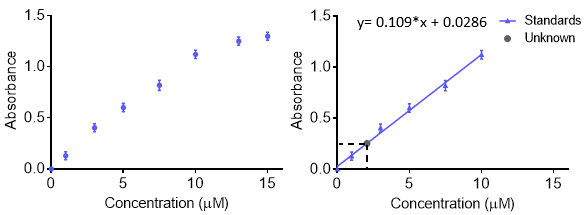検量線
概要
ソース: 研究所博士 b. ジル Venton - ヴァージニアの大学の
検量線は、検体を機器の応答を理解し、未知試料の濃度を予測に使用されます。一般的には、標準試料のセットは、興味の未知が含まれていますよりも範囲で種々 の濃度に作られています、各濃度で楽器の応答が記録されます。高い精度とエラーを理解するのは、エラー バーが得られるように各濃度で応答を繰り返すことができます。未知濃度を予測できるように、データは関数と合うし。通常線形応答、曲線が他の機能で行うことが関数は知られている限りでは、しかし、です。検量線は、検出限界と定量限界の計算に使用できます。
較正曲線のためのソリューションの際、各ソリューションを個別に可能です。ただし、開始材料の多くを取るし、時間がかかるをことができます。ソリューションの多くの異なる濃度を作るための別の方法は、シリアルの希薄を使用することです。シリアル希釈で集中のサンプルは低濃度を段階的に下に希薄化します。次のサンプルは前希釈からなされ、希釈倍率を一定に保たれる多くの場合。利点は、1 つだけの最初のソリューションが必要であります。欠点ソリューション作成のエラーは、-ピペッティング、マス、等-より多くのソリューションが行われるとに反映されます。初期解の際、注意が必要があります。
手順
1、基準を作る: シリアル希薄
- 標準の濃縮原液を作る。通常、化合物は、正確に計り、定量的、メスフラスコに転送されます。いくつかの溶剤を追加、サンプルが溶解するのでミックスを適切な溶媒との行に入力されます。
- シリアルの希薄を実行します。別のメスフラスコを取ると、希釈に必要な標準量をピペット、溶媒との行に記入し、混ぜます。だから 10 mL メスフラスコ、10 倍希釈が行われた通常、前希釈の 1 mL を追加します。
- 次のサンプルを作ることを希釈する前のソリューションのピペッティングより多くの希薄のため必要に応じて継続します。良い校正曲線の少なくとも 5 の濃度が必要です。
2. 校正曲線と未知のサンプルを実行します。
- 検量線に必要な楽器の応答を判断する紫外可視分光光度計のサンプルを実行します。
- 最初のサンプルに読書を取る。体系的なエラーがある場合、ランダムな順序 (すなわちない最低または最高に最低に最高) でサンプルを実行することをお勧めします。
申請書と概要
スキップ先...
このコレクションのビデオ:

Now Playing
検量線
Analytical Chemistry
797.0K 閲覧数

試料分析の準備のため
Analytical Chemistry
84.8K 閲覧数

社内基準
Analytical Chemistry
204.8K 閲覧数

標準添加法
Analytical Chemistry
320.2K 閲覧数

(紫外-可視) 紫外可視分光法
Analytical Chemistry
623.7K 閲覧数

ラマン分光を用いた化学分析
Analytical Chemistry
51.2K 閲覧数

蛍光 x 線 (XRF)
Analytical Chemistry
25.4K 閲覧数

炎イオン化検出ガスクロマトグラフィー (GC)
Analytical Chemistry
282.1K 閲覧数

高速液体クロマトグラフィー (HPLC)
Analytical Chemistry
384.6K 閲覧数

イオン交換クロマトグラフィー
Analytical Chemistry
264.6K 閲覧数

キャピラリー電気泳動 (CE)
Analytical Chemistry
94.0K 閲覧数

質量分析への紹介
Analytical Chemistry
112.3K 閲覧数

走査型電子顕微鏡 (SEM)
Analytical Chemistry
87.2K 閲覧数

ポテンショスタット/Galvanostat を使用して担持触媒の電気化学測定
Analytical Chemistry
51.4K 閲覧数

サイクリックボルタンメトリー (CV)
Analytical Chemistry
125.3K 閲覧数
Copyright © 2023 MyJoVE Corporation. All rights reserved
